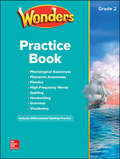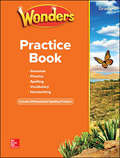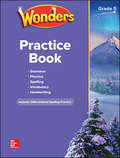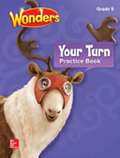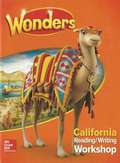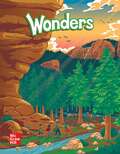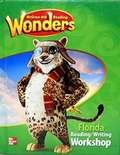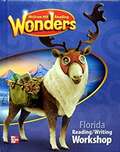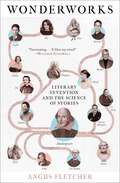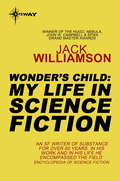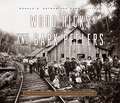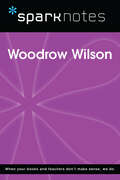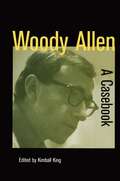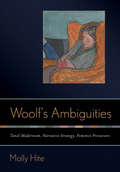- Table View
- List View
Wonders, Practice Book, Grade 2
by McGraw-Hill EducationNIMAC-sourced textbook <P><P>Blackline masters that provide multiple opportunities for students to master skills and strategies. The Practice Book features phonological awareness, phonemic awareness, phonics, spelling, handwriting, high-frequency words, category words, and grammar practice for each week of instruction, plus take-home stories.
Wonders, Practice Book, Grade 3
by McGraw-Hill EducationNIMAC-sourced textbook <P><P>Blackline masters that provide multiple opportunities for students to master skills and strategies. The Practice Book features phonological awareness, phonemic awareness, phonics, spelling, handwriting, high-frequency words, category words, and grammar practice for each week of instruction, plus take-home stories.
Wonders, Practice Book, Grade 5
by McGraw-Hill EducationNIMAC-sourced textbook <P><P>Blackline masters that provide multiple opportunities for students to master skills and strategies. The Practice Book features phonological awareness, phonemic awareness, phonics, spelling, handwriting, high-frequency words, category words, and grammar practice for each week of instruction, plus take-home stories.
Wonders, Reading/Writing Workshop, Florida Edition
by McGraw Hill*This textbook has been transcribed in UEB, formatted according to Braille textbook formats, proofread and corrected. <P><P>
Wonders, Your Turn Practice Book, Grade 5 (Elementary Core Reading Series)
by Donald Bear McGraw HillProvides students with their first guided practice, with fresh reading selections every week. Students can underline, circle, and highlight text to support answers with text evidence.
Wonders, [Grade 3], Reading/Writing Workshop
by Donald R. Bear Janice A. Dole Diane AugustNIMAC-sourced textbook
Wonders: Reading/Writing Workshop, 4th Grade (Florida Edition)
by McGraw-Hill Staff<p>Unlock the Wonders of Reading! <p>With your Florida Reading/Writing Workshop you will: <p> <li>Talk About New Ideas <li>Read and Reread Exciting Literature <li>Read and Reread Informational Text <li>Look for Text Evidence <li>Access Complex Text <li>Be an Expert Writer <li>Do Your Own Research </p>
Wonders: Reading/Writing Workshop, 5th Grade (Florida Edition)
by McGraw-Hill Staff<p>Unlock the Wonders of Reading! <p>With your Florida Reading/Writing Workshop you will: <p> <li>Talk About New Ideas <li>Read and Reread Exciting Literature <li>Read and Reread Informational Text <li>Look for Text Evidence <li>Access Complex Text <li>Be an Expert Writer <li>Do Your Own Research</li> </p>
Wonderworks: The 25 Most Powerful Inventions in the History of Literature
by Angus FletcherThis &“fascinating&” (Malcolm Gladwell, New York Times bestselling author of Outliers) examination of literary inventions through the ages, from ancient Mesopotamia to Elena Ferrante, shows how writers have created technical breakthroughs—rivaling scientific inventions—and engineering enhancements to the human heart and mind.Literature is a technology like any other. And the writers we revere—from Homer, Shakespeare, Austen, and others—each made a unique technical breakthrough that can be viewed as both a narrative and neuroscientific advancement. Literature&’s great invention was to address problems we could not solve: not how to start a fire or build a boat, but how to live and love; how to maintain courage in the face of death; how to account for the fact that we exist at all. Wonderworks reviews the blueprints for twenty-five of the most significant developments in the history of literature. These inventions can be scientifically shown to alleviate grief, trauma, loneliness, anxiety, numbness, depression, pessimism, and ennui, while sparking creativity, courage, love, empathy, hope, joy, and positive change. They can be found throughout literature—from ancient Chinese lyrics to Shakespeare&’s plays, poetry to nursery rhymes and fairy tales, and crime novels to slave narratives. A &“refreshing and remarkable&” (Jay Parini, author of Borges and Me: An Encounter) exploration of the new literary field of story science, Wonderworks teaches you everything you wish you learned in your English class, and &“contains many instances of critical insight....What&’s most interesting about this compendium is its understanding of imaginative representation as a technology&” (The New York Times).
Wonder’s Child: My Life in Science Fiction
by Jack WilliamsonScience fiction legend Jack Williamson’s classic autobiography is much more than the story of a single man’s life and work; it is an amazing look at the entire 20th century from the perspective of a man on a "long search for endurable compromise with society." Born in 1908, Williamson often felt at odds with the world around him and began writing science fiction as a method of escape. His tentative entrance into the field - his first story was published in 1928 in Hugo Gernsbach’s legendary Amazing Stories - soon transformed him from a pulp writer into one of the Grand Masters of science fiction.
Wood Hicks and Bark Peelers: A Visual History of Pennsylvania’s Railroad Lumbering Communities; The Photographic Legacy of William T. Clarke (Keystone Books)
by Ronald E. Ostman Harry LittellIn Wood Hicks and Bark Peelers, Ronald E. Ostman and Harry Littell draw on the stunning documentary photography of William T. Clarke to tell the story of Pennsylvania’s lumber heyday, a time when loggers serving the needs of a rapidly growing and globalizing country forever altered the dense forests of the state’s northern tier.Discovered in a shed in upstate New York and a barn in Pennsylvania after decades of obscurity, Clarke’s photographs offer an unprecedented view of the logging, lumbering, and wood industries during the late nineteenth and early twentieth centuries. They show the great forests in the process of coming down and the trains that hauled away the felled trees and trimmed logs. And they show the workers—cruisers, jobbers, skidders, teamsters, carpenters, swampers, wood hicks, and bark peelers—their camps and workplaces, their families, their communities. The work was demanding and dangerous; the work sites and housing were unsanitary and unsavory. The changes the newly industrialized logging business wrought were immensely important to the nation’s growth at the same time that they were fantastically—and tragically—transformative of the landscape. An extraordinary look at a little-known photographer’s work and the people and industry he documented, this book reveals, in sharp detail, the history of the third phase of lumber in America.
Wood Hicks and Bark Peelers: A Visual History of Pennsylvania’s Railroad Lumbering Communities; The Photographic Legacy of William T. Clarke (Keystone Books)
by Ronald E. Ostman Harry LittellIn Wood Hicks and Bark Peelers, Ronald E. Ostman and Harry Littell draw on the stunning documentary photography of William T. Clarke to tell the story of Pennsylvania’s lumber heyday, a time when loggers serving the needs of a rapidly growing and globalizing country forever altered the dense forests of the state’s northern tier.Discovered in a shed in upstate New York and a barn in Pennsylvania after decades of obscurity, Clarke’s photographs offer an unprecedented view of the logging, lumbering, and wood industries during the late nineteenth and early twentieth centuries. They show the great forests in the process of coming down and the trains that hauled away the felled trees and trimmed logs. And they show the workers—cruisers, jobbers, skidders, teamsters, carpenters, swampers, wood hicks, and bark peelers—their camps and workplaces, their families, their communities. The work was demanding and dangerous; the work sites and housing were unsanitary and unsavory. The changes the newly industrialized logging business wrought were immensely important to the nation’s growth at the same time that they were fantastically—and tragically—transformative of the landscape. An extraordinary look at a little-known photographer’s work and the people and industry he documented, this book reveals, in sharp detail, the history of the third phase of lumber in America.
Wooden Os
by Vin NardizziWooden Os is a study of the presence of trees and wood in the drama of Shakespeare and his contemporaries - in plays set within forests, in character dialogue, and in props and theatre constructions. Vin Nardizzi connects these themes to the dependence, and surprising ecological impact, of London's commercial theatre industry on England's woodlands, the primary resource required to build all structures in early modern England.Wooden Os situates the theatre within an environmental history that witnessed a perceived scarcity of wood and timber that drove up prices, as well as statute law prohibiting the devastation of English woodlands and urgent calls for the remedying of a resource shortage that was feared would result in eco-political collapse. By considering works including Friar Bacon and Friar Bungay, the revised Spanish Tragedy, and The Tempest, Nardizzi demonstrates how the "trees" within them were used in imaginative ways to mediate England's resource crisis.
Woodrow Wilson (SparkNotes Biography Guide)
by SparkNotesWoodrow Wilson (SparkNotes Biography Guide) Making the reading experience fun! SparkNotes Biography Guides examine the lives of historical luminaries, from Alexander the Great to Virginia Woolf. Each biography guide includes:An examination of the historical context in which the person lived A summary of the person&’s life and achievements A glossary of important terms, people, and events An in-depth look at the key epochs in the person&’s career Study questions and essay topics A review test Suggestions for further reading Whether you&’re a student of history or just a student cramming for a history exam, SparkNotes Biography guides are a reliable, thorough, and readable resource.
Woodward and Bernstein: Life in the Shadow of Watergate
by Alicia ShepardHow the reporters fared after their big story.
Woody Allen: A Casebook
by Kimball KingFirst Published in 2001. Routledge is an imprint of Taylor & Francis, an informa company.
Woolf’s Ambiguities: Tonal Modernism, Narrative Strategy, Feminist Precursors
by Molly HiteIn a book that compares Virginia Woolf's writing with that of the novelist, actress, and feminist activist Elizabeth Robins (1862–1952), Molly Hite explores the fascinating connections between Woolf's aversion to women's "pleading a cause" in fiction and her narrative technique of complicating, minimizing, or omitting tonal cues. Hite shows how A Room of One's Own, Mrs. Dalloway, and The Voyage Out borrow from and implicitly criticize Robins's work.Hite presents and develops the concept of narrative tone as a means to enrich and complicate our readings of Woolf's modernist novels. In Woolf's Ambiguities, she argues that the greatest formal innovation in Woolf's fiction is the muting, complicating, or effacing of textual pointers guiding how readers feel and make ethical judgments about characters and events. Much of Woolf's narrative prose, Hite proposes, thus refrains from endorsing a single position, not only adding value ambiguity to the cognitive ambiguity associated with modernist fiction generally, but explicitly rejecting the polemical intent of feminist novelists in the generation preceding her own. Hite also points out that Woolf reconsidered her rejection of polemical fiction later in her career. In the unfinished draft of her "essay-nove;" The Pargiters, Woolf created a brilliant new narrative form allowing her to make unequivocal value judgments.
Word Art + Gesture Art = Tone Art: The Relationship Between the Vocal and the Instrumental in Different Arts
by Hanns-Werner Heister Hanjo Polk Bernhard RusamThis book offers a truly interdisciplinary discussion on the relationship between the vocal and the instrumental in music and other arts and in everyday communication alike. Presenting an in-depth systematical and historical analysis of the evolution of word and gesture art, it gives extensive information on the anthropological, biological, and physiological influences and interactions in music and beyond. The book gives a unique definition of the genuinely vocal and instrumental from their generative deep structure: They derive from and are determined in their production by the duality of voice and hands, and in terms of product as the tone or ‘tonal’ on the one hand, and the percussive, that is noise plus rhythm, on the other. This book succeeds in bringing together perspectives from art, and from natural and social sciences, merging them to offer new explanations about the relationship between the vocal and instrumental, and eventually about the origins of music, arts, and language. It offers new perspectives on the intertwining between the vocal and the instrumental, specifically in the context of the expressions of human languages. At the same time, this book aims at clarifying and explaining the role of words and gestures in different contexts, such as society and communication, education, and arts.
